A Novel Thiophene-Based Fluorescent Chemosensor for the Detection of Zn2+ and CN−: Imaging Applications in Live Cells and Zebrafish
Abstract
1. Introduction
2. Experimental
2.1. Reagents and Equipments
2.2. Synthesis of Sensor DHADC ((E)-3-((4-(diethylamino)-2-hydroxybenzylidene)amino)-2,3-dihydrothiophene-2-carboxamide)
2.3. Fluorescence Titrations
2.4. UV-vis Titrations
2.5. Job Plots
2.6. Competition Tests
2.7. 1H NMR Titrations
2.8. Quantum Yields
2.9. Quantification of Zn2+ in Real Samples
2.10. Imaging in Live Cells and Zebrafish
3. Results and Discussion
3.1. Fluorescence Investigation of DHADC to Metal Cations
3.2. Fluorescence Studies of Compound DHADC to CN−
4. Conclusions
Supplementary Materials
Author Contributions
Funding
Conflicts of Interest
References
- Aragay, G.; Pons, J.; Merkoçi, A. Recent trends in macro-, micro-, and nanomaterial-based tools and strategies for heavy-metal detection. Chem. Rev. 2011, 111, 3433–3458. [Google Scholar] [CrossRef] [PubMed]
- Chen, Y.; Bai, Y.; Han, Z.; He, W.; Guo, Z. Photoluminescence imaging of Zn2+ in living systems. Chem. Soc. Rev. 2015, 44, 4517–4546. [Google Scholar] [CrossRef] [PubMed]
- Xu, Z.; Yoon, J.; Spring, D.R. Fluorescent chemosensors for Zn2+. Chem. Soc. Rev. 2010, 39, 1996–2006. [Google Scholar] [CrossRef] [PubMed]
- Li, W.; Tian, X.; Huang, B.; Li, H.; Zhao, X.; Gao, S.; Zheng, J.; Zhang, X.; Zhou, H.; Tian, Y.; et al. Triphenylamine-based Schiff bases as the High sensitive Al3+ or Zn2+ fluorescence turn-on probe: Mechanism and application in vitro and in vivo. Biosens. Bioelectron. 2016, 77, 530–536. [Google Scholar] [CrossRef]
- Choi, J.Y.; Kim, D.; Yoon, J. A highly selective “turn-on” fluorescent chemosensor based on hydroxy pyrene-hydrazone derivative for Zn2+. Dyes Pigm. 2013, 96, 176–179. [Google Scholar] [CrossRef]
- Hagimori, M.; Taniura, M.; Mizuyama, N.; Karimine, Y.; Kawakami, S.; Saji, H.; Mukai, T. Synthesis of a novel pyrazine-pyridone biheteroaryl-based fluorescence sensor and detection of endogenous labile zinc ions in lung cancer cells. Sensors 2019, 19, 2049. [Google Scholar] [CrossRef]
- Guo, Z.; Kim, G.H.; Yoon, J.; Shin, I. Synthesis of a highly Zn2+-selective cyanine-based probe and its use for tracing endogenous zinc ions in cells and organisms. Nat. Protoc. 2014, 9, 1245–1254. [Google Scholar] [CrossRef]
- Sohrabi, M.; Amirnasr, M.; Farrokhpour, H.; Meghdadi, S. A single chemosensor with combined ionophore/fluorophore moieties acting as a fluorescent “Off-On” Zn2+ sensor and a colorimetric sensor for Cu2+: Experimental, logic gate behavior and TD-DFT calculations. Sens. Actuators B Chem. 2017, 250, 647–658. [Google Scholar] [CrossRef]
- Bhanja, A.K.; Patra, C.; Mondal, S.; Mishra, S.; Saha, K.D.; Sinha, C. Macrocycle aza-crown chromogenic reagent to Al3+ and fluorescence sensor for Zn2+ and Al3+ along with live cell application and logic operation. Sens. Actuators B Chem. 2017, 252, 257–267. [Google Scholar] [CrossRef]
- Kim, M.S.; Jo, T.G.; Ahn, H.M.; Kim, C. A Colorimetric and Fluorescent Chemosensor for the Selective Detection of Cu2+ and Zn2+ Ions. J. Fluoresc. 2016, 27, 357–367. [Google Scholar] [CrossRef]
- Das, B.; Jana, A.; Mahapatra, A.D.; Chattopadhyay, D.; Dhara, A.; Mabhai, S.; Dey, S. Fluorescein derived Schiff base as fluorimetric zinc(II) sensor via ‘turn on’ response and its application in live cell imaging. Spectrochim. Acta A 2019, 212, 222–231. [Google Scholar] [CrossRef] [PubMed]
- Yang, X.; Li, Y.; Ding, Y.; Zhao, Z.; Zhang, Y.; Liu, X.; Fu, Z.; Cui, Y.; Sun, G.; Zhang, G.; et al. Ratiometric & reversible fluorescent sensing of NaCN by an effective probe based on phenanthro [9,10-d]imidazole platform. Sens. Actuators B Chem. 2017, 253, 478–487. [Google Scholar]
- Maurya, N.; Bhardwaj, S.; Singh, A.K. A modest colorimetric chemosensor for investigation of CN− in semi-aqueous environment with high selectivity and sensitivity. Sens. Actuators B Chem. 2016, 229, 483–491. [Google Scholar] [CrossRef]
- Sarkar, A.; Bhattacharyya, S.; Mukherjee, A. Colorimetric detection of fluoride ions by anthraimidazoledione based sensors in the presence of Cu(II) ions. Dalton Trans. 2016, 45, 1166–1175. [Google Scholar] [CrossRef]
- Jo, T.G.; Na, Y.J.; Lee, J.J.; Lee, M.M.; Lee, S.Y.; Kim, C. A multifunctional colorimetric chemosensor for cyanide and copper(II) ions. Sens. Actuators B Chem. 2015, 211, 498–506. [Google Scholar] [CrossRef]
- You, G.R.; Park, G.J.; Lee, J.J.; Kim, C. A colorimetric sensor for the sequential detection of Cu2+ and CN− in fully aqueous media: Practical performance of Cu2+. Dalton Trans. 2015, 44, 9120–9129. [Google Scholar] [CrossRef]
- Sheshashena Reddy, T.; Maragani, R.; Misra, R. Triarylborane substituted naphthalimide as a fluoride and cyanide ion sensor. Dalton Trans. 2016, 45, 2549–2553. [Google Scholar] [CrossRef]
- Kim, D.; Na, S.Y.; Kim, H.J. A fluorescence turn-on probe for a catalytic amount of cyanides through the cyanide-mediated cinnamate-to-coumarin transformation. Sens. Actuators B Chem. 2016, 226, 227–231. [Google Scholar] [CrossRef]
- Hachiya, H.; Ito, S.; Fushinuki, Y.; Masadome, T.; Asano, Y.; Imato, T. Continuous monitoring for cyanide in waste water with a galvanic hydrogen cyanide sensor using a purge system. Talanta 1999, 48, 997–1004. [Google Scholar] [CrossRef]
- Zhang, X.; Chen, S.; Jin, S.; Lu, X.; Li, L.; Chen, X.; Shu, Q. Naphthalene based lab-on-a-molecule for the highly selective and sensitive detection of CN− and Ag+ in aqueous solution. Sens. Actuators B Chem. 2016, 237, 367–372. [Google Scholar] [CrossRef]
- Elsafy, A.G.; Al-Easa, H.S.; Hijji, Y.M. Substituted 2-aminobenzothiazoles salicylidenes synthesis and characterization as cyanide sensors in aqueous medium. Sensors 2018, 18, 2219. [Google Scholar] [CrossRef] [PubMed]
- Khairnar, N.; Tayade, K.; Sahoo, S.K.; Bondhopadhyay, B.; Basu, A.; Singh, J.; Singh, N.; Gite, V.; Kuwar, A. A highly selective fluorescent ‘turn-on’ chemosensor for Zn2+ based on a benzothiazole conjugate: Their applicability in live cell imaging and use of the resultant complex as a secondary sensor of CN−. Dalton Trans. 2015, 44, 2097–2102. [Google Scholar] [CrossRef] [PubMed]
- “First pass phenomenon” of inhaled gas in the fire victims. Forensic Sci. Int. 1990, 46, 203–208. [CrossRef]
- Shi, Z.; Tu, Y.; Wang, R.; Liu, G.; Pu, S. Highly sensitive and selective turn-on fluorescent sensor for dual recognition of Cu2+ and CN− based on a methylquinoline derivative. Dyes Pigm. 2018, 149, 764–773. [Google Scholar] [CrossRef]
- Ryu, K.Y.; Lee, J.J.; Kim, J.A.; Park, D.Y.; Kim, C. Colorimetric chemosensor for multiple targets, Cu2+, CN− and S2−. RSC Adv. 2016, 6, 16586–16597. [Google Scholar] [CrossRef]
- Liang, M.; Wang, K.; Guan, R.; Liu, Z.; Cao, D.; Wu, Q.; Shan, Y.; Xu, Y.; Luo, Z.; Yin, K.; et al. Several hemicyanine dyes as fluorescence chemosensors for cyanide anions. Spectrochim. Acta A 2016, 169, 34–38. [Google Scholar] [CrossRef]
- Keshav, K.; Torawane, P.; Kumar Kumawat, M.; Tayade, K.; Sahoo, S.K.; Srivastava, R.; Kuwar, A. Highly selective optical and reversible dual-path chemosensor for cyanide detection and its application in live cells imaging. Biosens. Bioelectron. 2017, 92, 95–100. [Google Scholar] [CrossRef]
- Zhang, W.; Xu, K.; Yue, L.; Shao, Z.; Feng, Y.; Fang, M. Two-dimensional carbazole-based derivatives as versatile chemosensors for colorimetric detection of cyanide and two-photon fluorescence imaging of viscosity in vitro. Dyes Pigm. 2017, 137, 560–568. [Google Scholar] [CrossRef]
- Park, G.J.; Hwang, I.H.; Song, E.J.; Kim, H.; Kim, C. A colorimetric and fluorescent sensor for sequential detection of copper ion and cyanide. Tetrahedron 2014, 70, 2822–2828. [Google Scholar] [CrossRef]
- Liu, D.; Yin, X.; Deng, X.; Shi, J.; Zhu, H.; Shang, Z.; Chen, J.; Yang, G.; He, H. 1, 8-Naphthalimide-based fluorescent sensor with highly selective and sensitive detection of Zn2+ in aqueous solution and living cells. Inorg. Chem. Commun. 2019, 106, 43–47. [Google Scholar] [CrossRef]
- Peng, M.J.; Guo, Y.; Yang, X.F.; Suzenet, F.; Li, J.; Li, C.W.; Duan, Y.W. Coumarin-hemicyanine conjugates as novel reaction-based sensors for cyanide detection: Convenient synthesis and ICT mechanism. RSC Adv. 2014, 4, 19077–19085. [Google Scholar] [CrossRef]
- Suganya, S.; Ravindran, E.; Mahato, M.K.; Prasad, E. Orange emitting fluorescence probe for the selective detection of cyanide ion in solution and solid states. Sens. Actuators B 2019, 291, 426–432. [Google Scholar] [CrossRef]
- Rezaeian, K.; Khanmohammadi, H.; Gholizadeh Dogaheh, S. Studies on a multifunctional chromo-fluorogenic sensor for dual channel recognition of Zn2+ and CN− ions in aqueous media: Mimicking multiple molecular logic gates and memory devices. New J. Chem. 2018, 42, 2158–2166. [Google Scholar] [CrossRef]
- Gao, W.; Li, H.; Zhang, Y.; Pu, S. A highly selective diarylethene chemosensor for dual channel recognition of CN− and Zn2+ and its application. Tetrahedron 2019, 75, 2538–2546. [Google Scholar] [CrossRef]
- Hu, J.H.; Sun, Y.; Qi, J.; Li, Q.; Wei, T.B. A new unsymmetrical azine derivative based on coumarin group as dual-modal sensor for CN− and fluorescent “OFF–ON” for Zn2+. Spectrochim. Acta A 2017, 175, 125–133. [Google Scholar] [CrossRef]
- Sun, S.; Shu, Q.; Lin, P.; Li, Y.; Jin, S.; Chen, X.; Wang, D. Triphenylamine based lab-on-a-molecule for the highly selective and sensitive detection of Zn2+ and CN− in aqueous solution. RSC Adv. 2016, 6, 93826–93831. [Google Scholar] [CrossRef]
- Li, Y.; Gu, Z.; He, T.; Yuan, X.; Zhang, Y.; Xu, Z.; Qiu, H.; Zhang, Q.; Yin, S. Terpyridyl-based triphenylamine derivatives with aggregation-induced emission characteristics for selective detection of Zn2+, Cd2+ and CN− ions and application in cell imaging. Dyes Pigm. 2020, 173, 107969. [Google Scholar] [CrossRef]
- Anand, T.; Kumar SK, A.; Sahoo, S.K. Vitamin B6 Cofactor Derivative: A Dual Fluorescent Turn-On Sensor to Detect Zn2+ and CN− Ions and Its Application in Live Cell Imaging. Chem. Select 2017, 2, 7570–7579. [Google Scholar] [CrossRef]
- Jung, J.M.; Yun, D.; Lee, H.; Kim, K.-T.; Kim, C. Selective chemosensor capable of sensing both CN− and Zn2+: Its application to zebrafish. Sens. Actuators B 2019, 297, 126814. [Google Scholar] [CrossRef]
- Jeong, H.Y.; Lee, S.Y.; Han, J.; Lim, M.H.; Kim, C. Thiophene and diethylaminophenol-based “turn-on” fluorescence chemosensor for detection of Al3+ and F- in a near-perfect aqueous solution. Tetrahedron 2017, 73, 2690–2697. [Google Scholar] [CrossRef]
- Wu, Y.; Guo, H.; James, T.D.; Zhao, J. Enantioselective Recognition of Mandelic Acid by a 3,6-Dithiophen-2-yl-9 H -carbazole-Based Chiral Fluorescent Bisboronic Acid Sensor. J. Org. Chem. 2011, 76, 5685–5695. [Google Scholar] [CrossRef] [PubMed]
- Kim, Y.S.; Lee, J.J.; Lee, S.Y.; Jo, T.G.; Kim, C. A highly sensitive benzimidazole-based chemosensor for the colorimetric detection of Fe(II) and Fe(III) and the fluorometric detection of Zn(II) in aqueous media. RSC Adv. 2016, 6, 61505–61515. [Google Scholar] [CrossRef]
- Na, Y.J.; Choi, Y.W.; Yun, J.Y.; Park, K.; Chang, P.; Kim, C. Dual-channel detection of Cu2+ and F− with a simple Schiff-based colorimetric and fluorescent sensor. Spectrochim. Acta A 2014, 136, 1649–1657. [Google Scholar] [CrossRef] [PubMed]
- Würth, C.; Grabolle, M.; Pauli, J.; Spieles, M.; Resch-Genger, U. Relative and absolute determination of fluorescence quantum yields of transparent samples. Nat. Protoc. 2013, 8, 1535–1550. [Google Scholar] [CrossRef] [PubMed]
- Job, P. Formation and stability of inorganic complexes in solution. Ann. Chim. Appl. 1928, 9, 113. [Google Scholar]
- Benesi, H.A.; Hildebrand, J.H. A Spectrophotometric Investigation of the Interaction of Iodine with Aromatic Hydrocarbons. J. Am. Chem. Soc. 1949, 71, 2703–2707. [Google Scholar] [CrossRef]
- Lin, H.-Y.; Cheng, P.-Y.; Wan, C.-F.; Wu, A.-T. A turn-on and reversible fluorescence sensor for zinc ion. Analyst 2012, 137, 4415–4417. [Google Scholar] [CrossRef]
- Hsieh, W.H.; Wan, C.F.; Liao, D.J.; Wu, A.T. A turn-on Schiff base fluorescence sensor for zinc ion. Tetrahedron Lett. 2012, 53, 5848–5851. [Google Scholar] [CrossRef]
- Choi, Y.W.; You, G.R.; Lee, J.J.; Kim, C. Turn-on fluorescent chemosensor for selective detection of Zn2+ in an aqueous solution: Experimental and theoretical studies. Inorg. Chem. Commun. 2016, 63, 35–38. [Google Scholar] [CrossRef]
- Purkait, R.; Mahapatra, A.D.; Chattopadhyay, D.; Sinha, C. An azine-based carbothioamide chemosensor for selective and sensitive turn-on-off sequential detection of Zn(II) and H2PO4−, live cell imaging and INHIBIT logic gate. Spectrochim. Acta A 2019, 207, 164–172. [Google Scholar] [CrossRef]
- Harrison, R.M.; Laxen, D.P.H.; Wilson, S.J. Chemical associations of lead, cadmium, copper, and zinc in street dusts and roadside soils. Environ. Sci. Technol. 1981, 15, 1378–1383. [Google Scholar] [CrossRef]
- Tsui, Y.-K.; Devaraj, S.; Yen, Y.-P. Azo dyes featuring with nitrobenzoxadiazole (NBD) unit: A new selective chromogenic and fluorogenic sensor for cyanide ion. Sens. Actuators B Chem. 2012, 161, 510–519. [Google Scholar] [CrossRef]
- Park, G.J.; Lee, J.J.; You, G.R.; Nguyen, L.; Noh, I.; Kim, C. A dual chemosensor for Zn2+ and Co2+ in aqueous media and living cells: Experimental and theoretical studies. Sens. Actuators B Chem. 2016, 223, 509–519. [Google Scholar] [CrossRef]
- Park, G.J.; Na, Y.J.; Jo, H.Y.; Lee, S.A.; Kim, A.R.; Noh, I.; Kim, C. A single chemosensor for multiple analytes: Fluorogenic detection of Zn2+ and OAc− ions in aqueous solution, and an application to bioimaging. New J. Chem. 2014, 38, 2587–2594. [Google Scholar] [CrossRef]
- Hwang, I.H.; Choi, Y.W.; Kim, K.B.; Park, G.J.; Lee, J.J.; Nguyen, L.; Noh, I.; Kim, C. A highly selective and sensitive fluorescent turn-on Al3+ chemosensor in aqueous media and living cells: Experimental and theoretical studies. New J. Chem. 2016, 40, 171–178. [Google Scholar] [CrossRef]
- Park, S.; Hong, K.H.; Hong, J.I.; Kim, H.J. Azo dye-based latent colorimetric chemodosimeter for the selective detection of cyanides in aqueous bis-tris buffer. Sens. Actuators B 2012, 174, 140–144. [Google Scholar] [CrossRef]
- Guo, Z.; Niu, Q.; Yang, Q.; Li, T.; Chi, H. A highly selective and sensitive dual-mode sensor for colorimetric and turn-on fluorescent detection of cyanide in water, agro-products and living cells. Anal. Chim. Acta 2019, 1065, 113–123. [Google Scholar] [CrossRef]
- Venkatesan, V.; Kumar, S.K.A.; Sahoo, S.K. Spectrophotometric and RGB performances of a new tetraphenylcyclopenta-derived Schiff base for the quantification of cyanide ions. Anal. Methods 2019, 11, 1137–1143. [Google Scholar] [CrossRef]

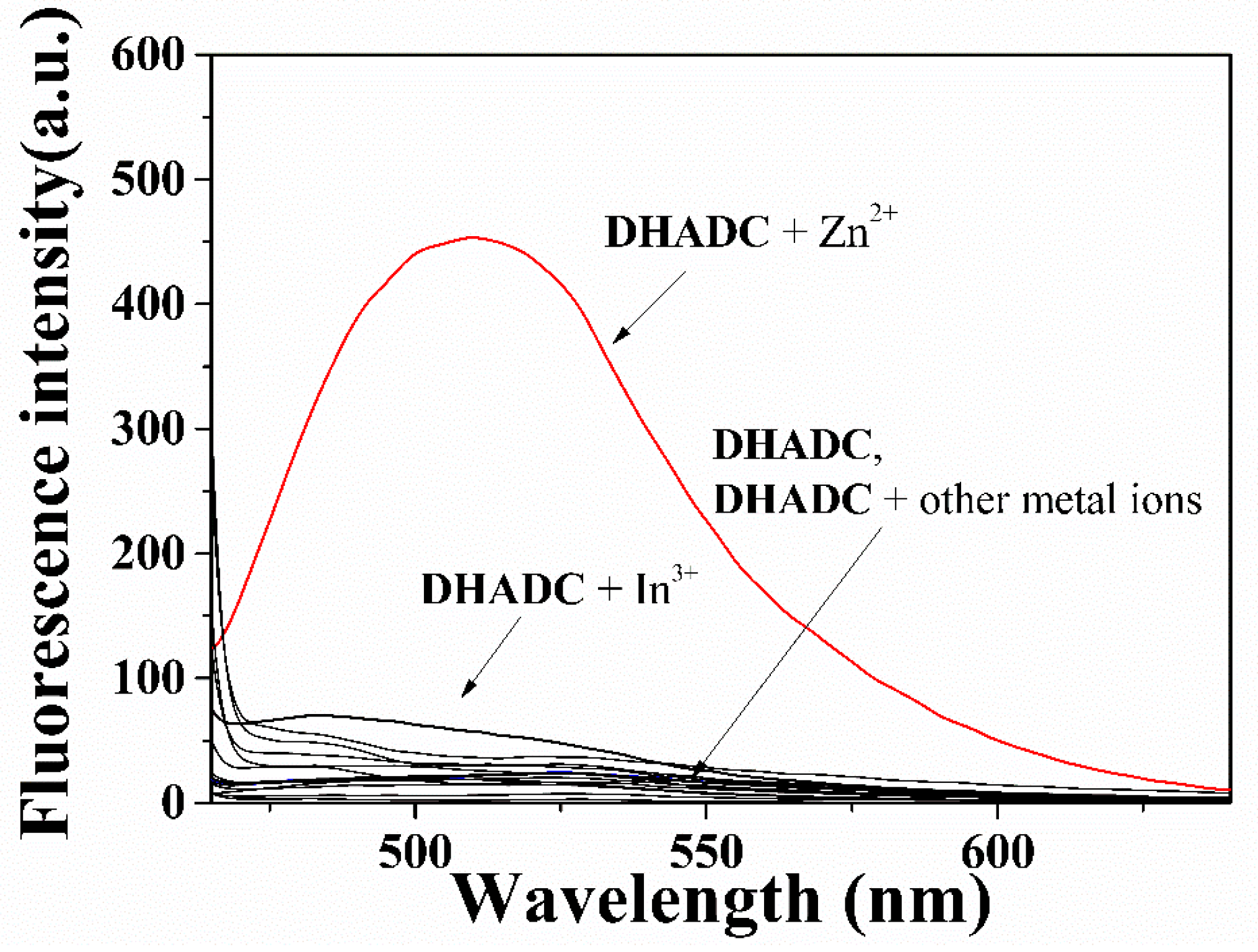

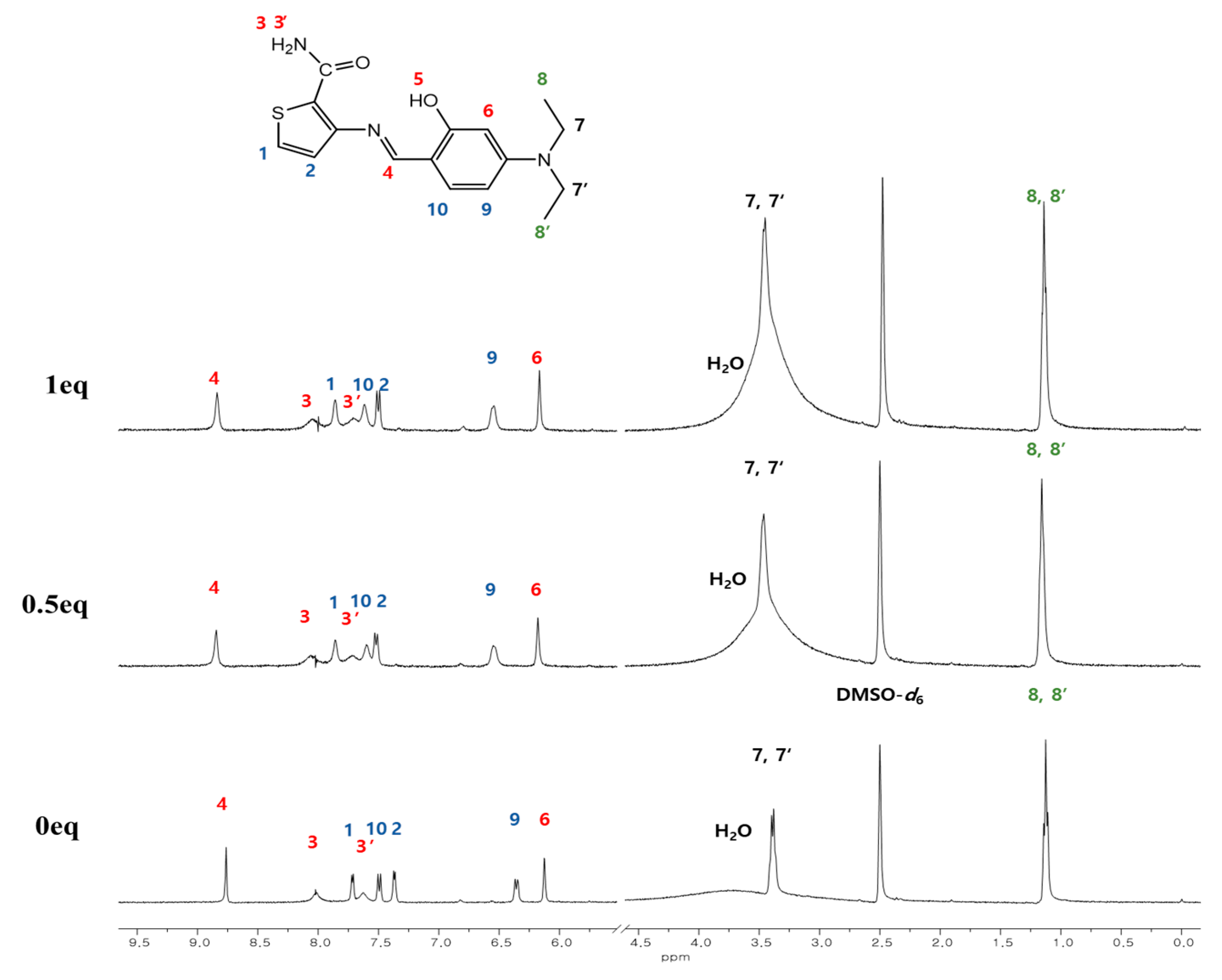

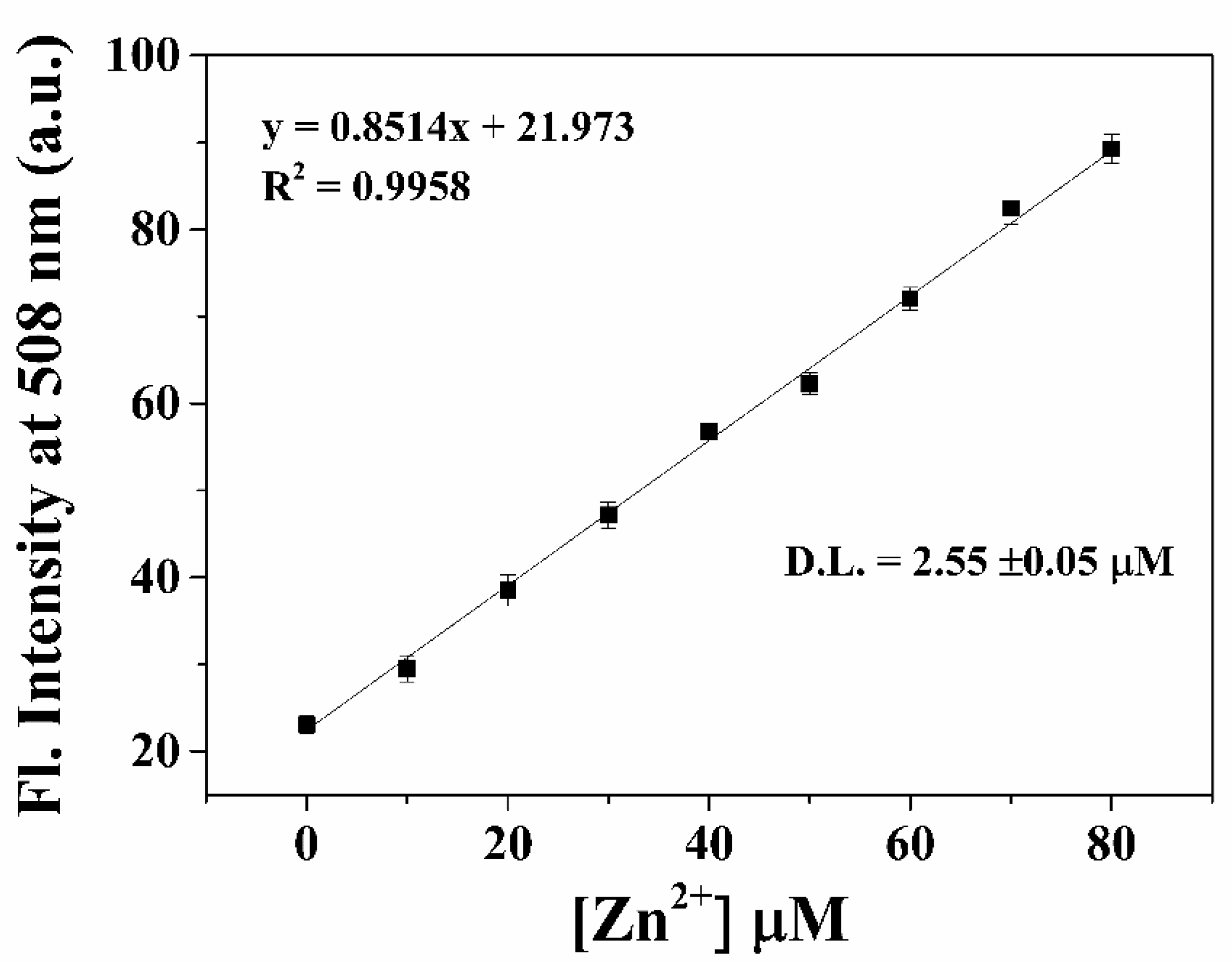
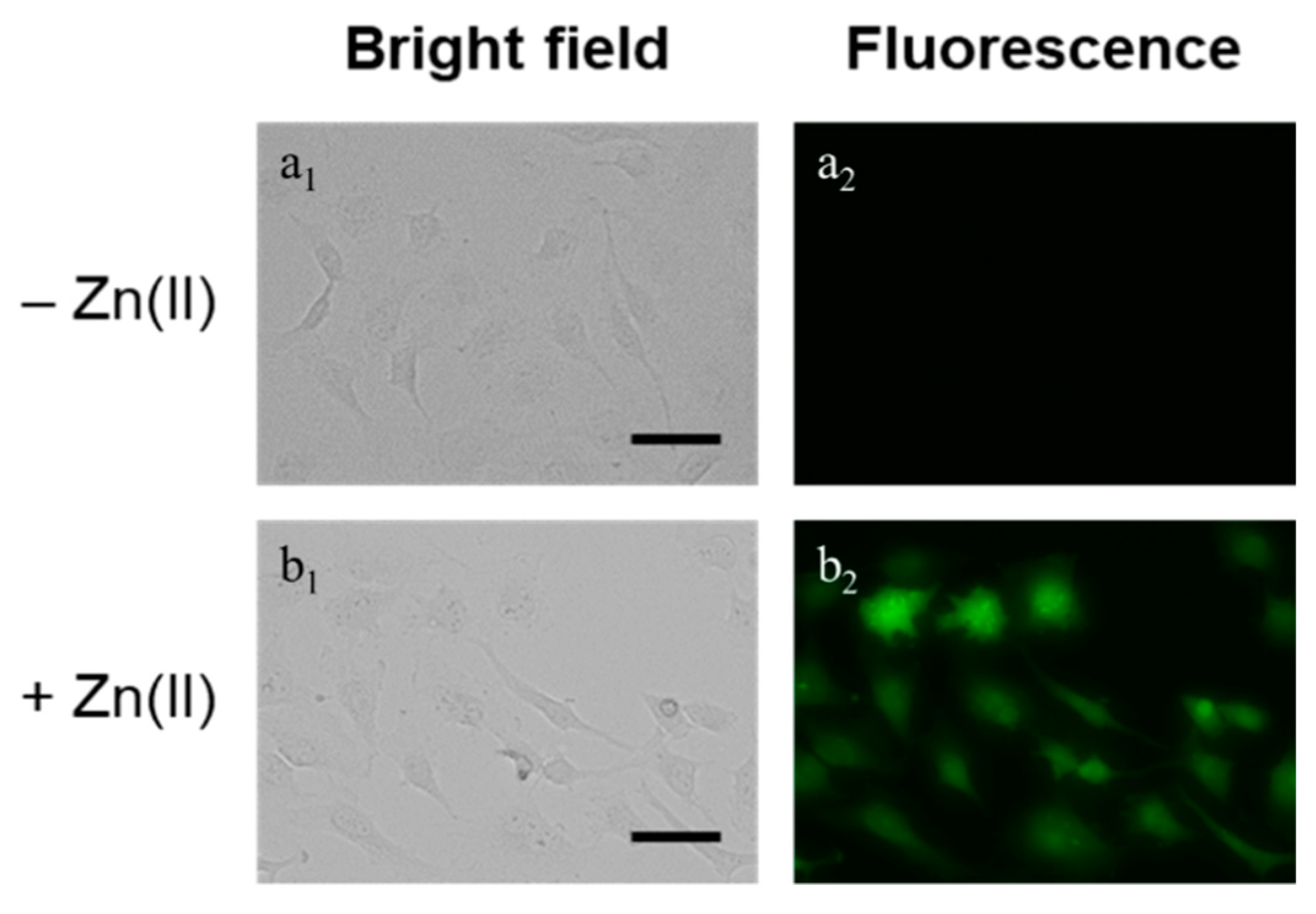
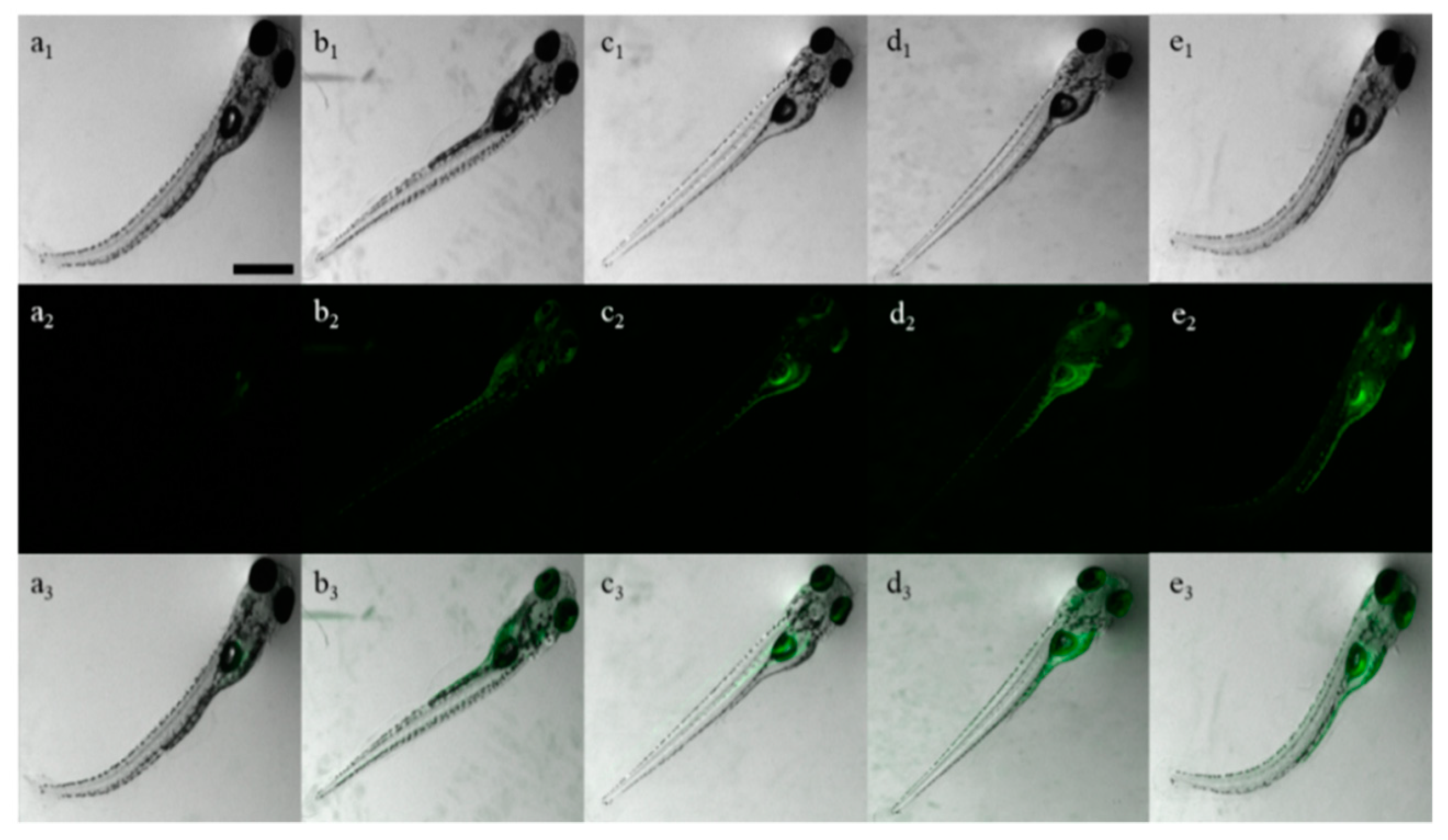
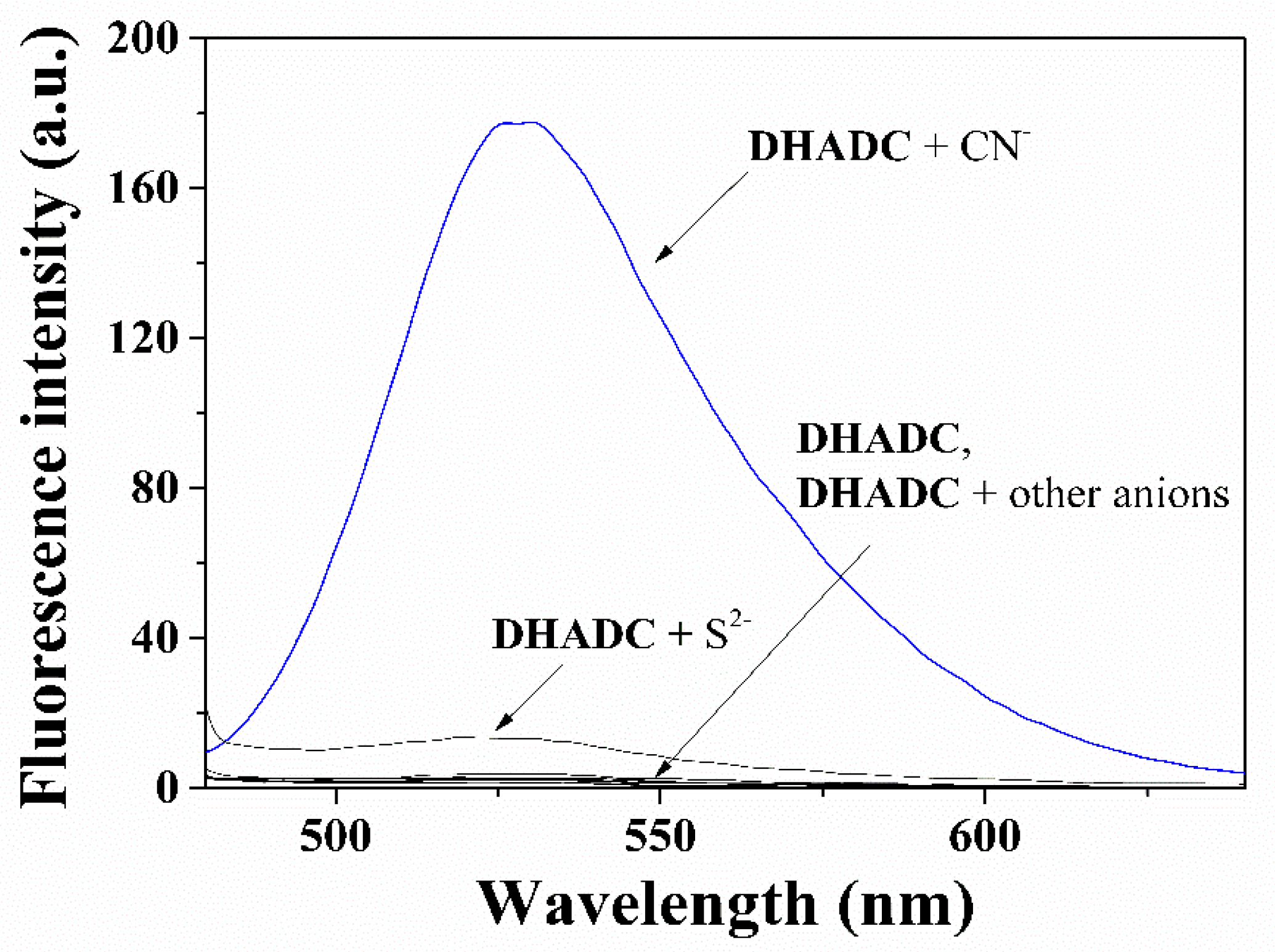
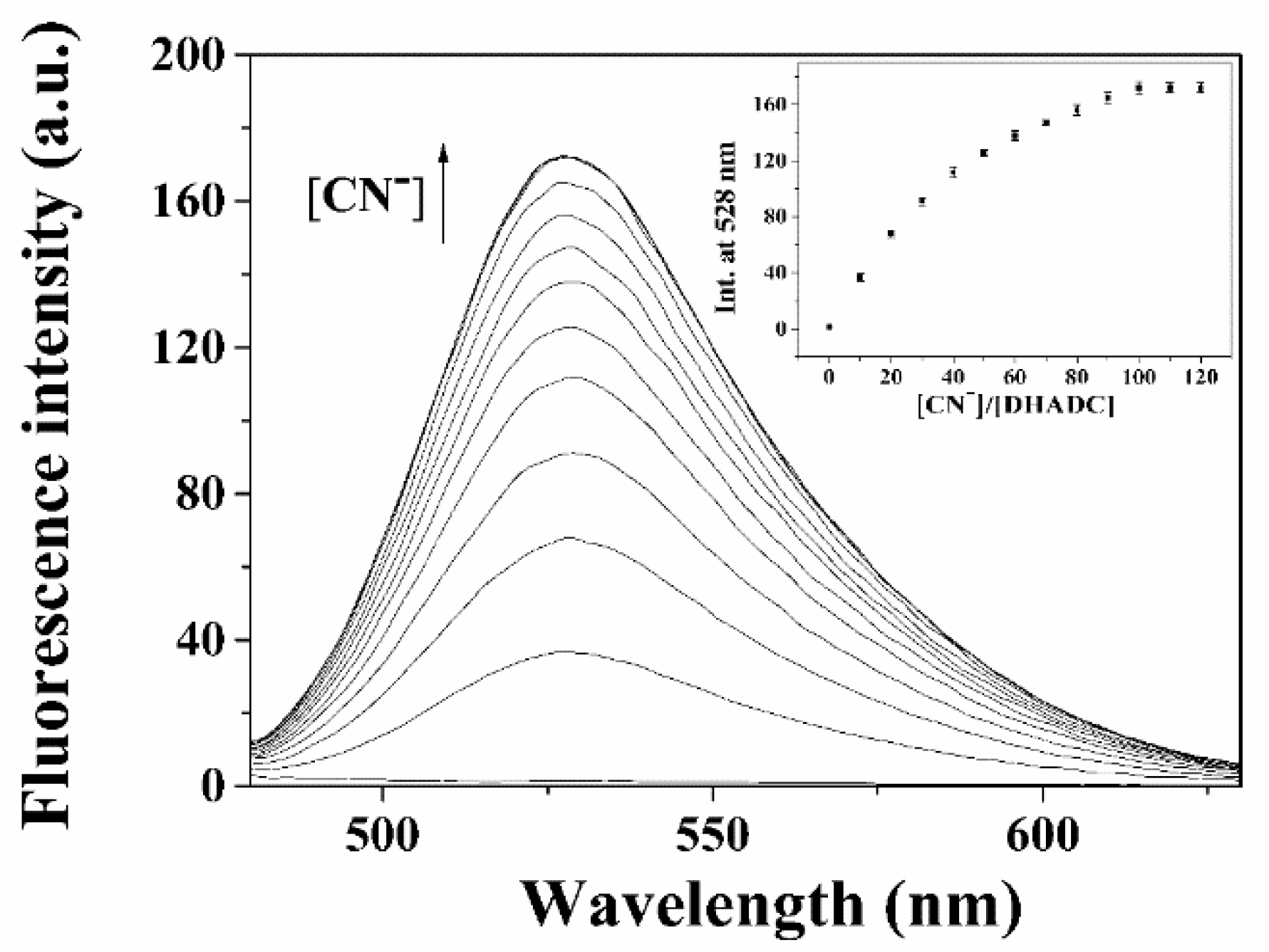


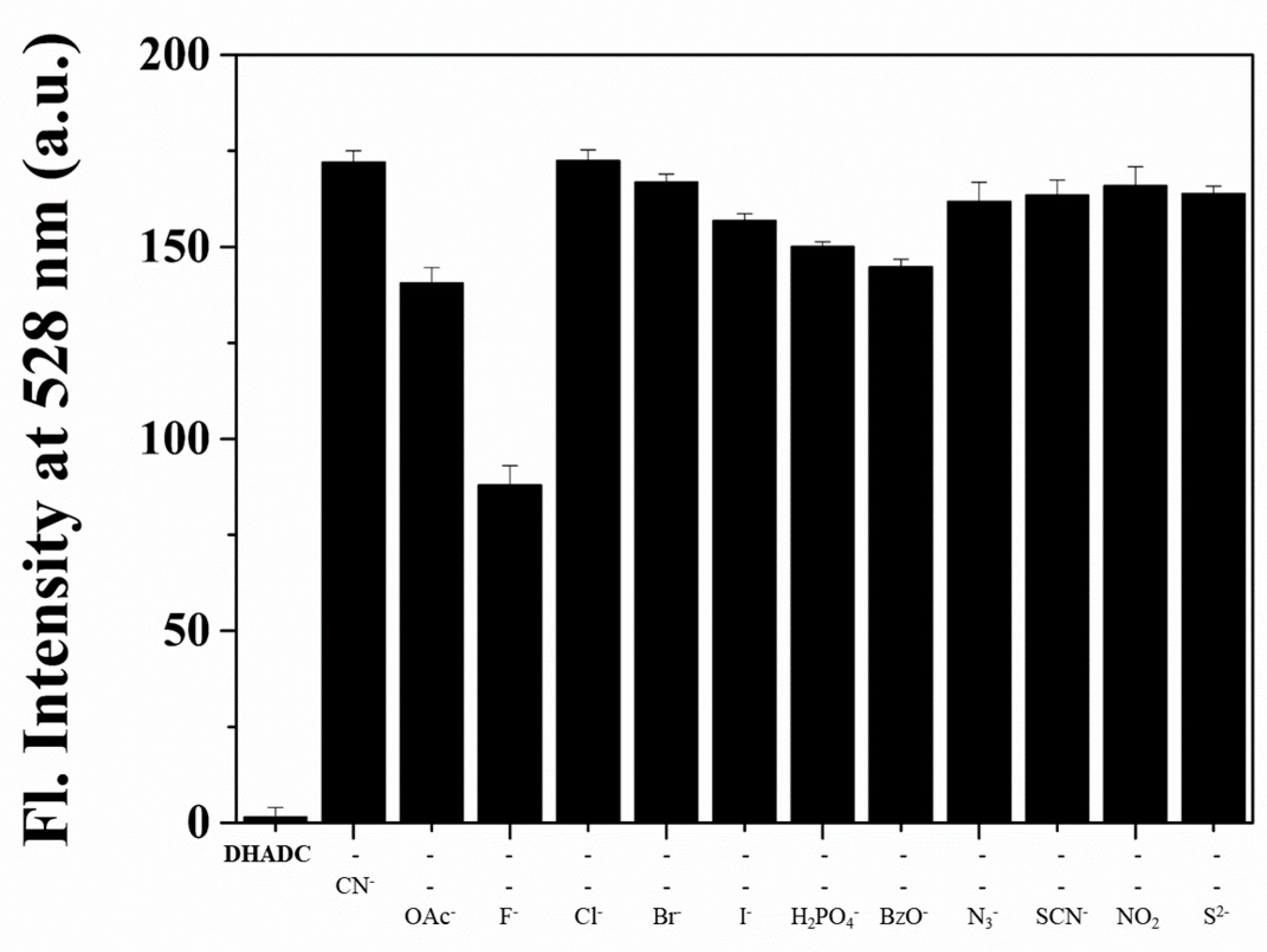
| Sample | Zn(II) Added (µmol/L) | Zn(II) Found (µmol/L) | Recovery (%) | R.S.D. (n = 3) (%) |
|---|---|---|---|---|
| Drinking Water | 0 | 0 | - | - |
| 20 | 19.1 ± 0.6 | 95.5 ± 1.0 | 3.96 ± 0.5 | |
| Tap Water | 0 | 0 | - | - |
| 20 | 19.7 ± 1.0 | 98.5 ± 1.4 | 1.51 ± 1.1 |
© 2019 by the authors. Licensee MDPI, Basel, Switzerland. This article is an open access article distributed under the terms and conditions of the Creative Commons Attribution (CC BY) license (http://creativecommons.org/licenses/by/4.0/).
Share and Cite
Kim, M.S.; Yun, D.; Chae, J.B.; So, H.; Lee, H.; Kim, K.-T.; Kim, M.; Lim, M.H.; Kim, C. A Novel Thiophene-Based Fluorescent Chemosensor for the Detection of Zn2+ and CN−: Imaging Applications in Live Cells and Zebrafish. Sensors 2019, 19, 5458. https://doi.org/10.3390/s19245458
Kim MS, Yun D, Chae JB, So H, Lee H, Kim K-T, Kim M, Lim MH, Kim C. A Novel Thiophene-Based Fluorescent Chemosensor for the Detection of Zn2+ and CN−: Imaging Applications in Live Cells and Zebrafish. Sensors. 2019; 19(24):5458. https://doi.org/10.3390/s19245458
Chicago/Turabian StyleKim, Min Seon, Dongju Yun, Ju Byeong Chae, Haeri So, Hyojin Lee, Ki-Tae Kim, Mingeun Kim, Mi Hee Lim, and Cheal Kim. 2019. "A Novel Thiophene-Based Fluorescent Chemosensor for the Detection of Zn2+ and CN−: Imaging Applications in Live Cells and Zebrafish" Sensors 19, no. 24: 5458. https://doi.org/10.3390/s19245458
APA StyleKim, M. S., Yun, D., Chae, J. B., So, H., Lee, H., Kim, K.-T., Kim, M., Lim, M. H., & Kim, C. (2019). A Novel Thiophene-Based Fluorescent Chemosensor for the Detection of Zn2+ and CN−: Imaging Applications in Live Cells and Zebrafish. Sensors, 19(24), 5458. https://doi.org/10.3390/s19245458








